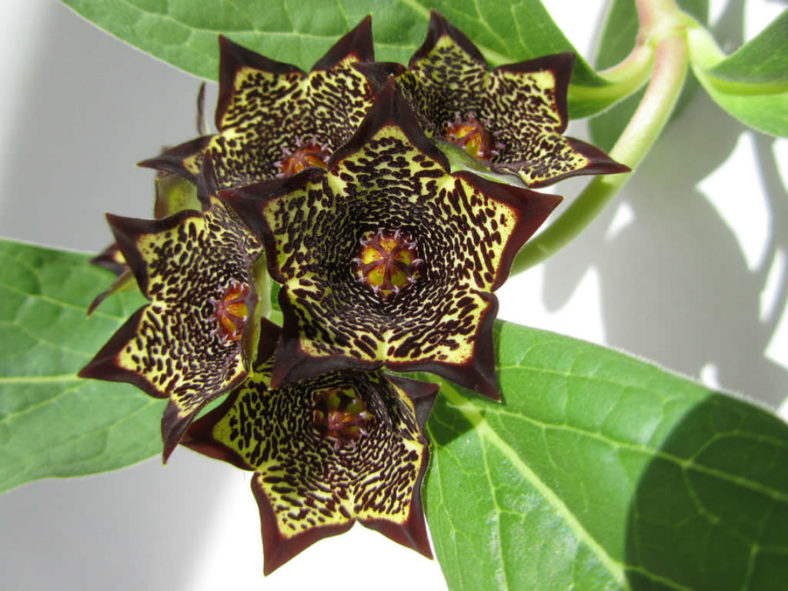Scientific Name
Ceropegia buchananii (N.E.Br.) Bruyns
Synonym(s)
Brachystelma buchananii, Brachystelma magicum, Brachystelma nauseosum, Brachystelma shirense
Scientific Classification
Family: Apocynaceae
Subfamily: Asclepiadoideae
Tribe: Ceropegieae
Genus: Ceropegia
Description
Ceropegia buchananii, formerly known as Brachystelma buchananii, is a perennial succulent with annual, erect or procumbent stems growing from a tuber. The leaves are green, ovate-elliptic, and measure up to 5 inches (12.5 cm) long and 2.8 inches (7 cm) wide. The tuber can reach up to 2 inches (5 cm) in diameter, while the branches can grow up to 12 inches (30 cm) long.
The flowers appear in 20 to 30-flowered terminal clusters in summer and fall. The corolla is wheel-shaped to somewhat cup-shaped, 5-lobed to halfway down, and can reach up to 1 inch (2.5 cm) in diameter. It is glabrous or more or less white-hairy on both sides, smooth and greenish on the outside and wrinkled, and cream with dark purple margins and stripes on the inside. The outer corona is cup-shaped with ten teeth, while the inner lobes are oblong.
Origin
Ceropegia buchananii is native to Botswana, Zimbabwe, Mozambique, Malawi, Zambia, Tanzania, Uganda, and Congo. It grows in grassy areas in Brachystegia woodland.
Etymology
The specific epithet "buchananii (byoo-kah-NAN-ee-eye)" honors John Buchanan (1819-1898), a New Zealand botanist and scientific artist.

Hardiness
USDA hardiness zone 10a to 11b: from 30 °F (−1.1 °C) to 50 °F (+10 °C).
How to Grow and Care
A gritty compost is suitable, and clay pots help with drainage, especially for the species with white thickened roots, which are the most susceptible to rotting, and for species forming large tubers. Ceropegias appreciate water and a little fertilizer during warm weather, although some care with watering is required for the more difficult species. The vine-like species can suffer from prolonged drought.
Typically, many of these species grow and climb naturally among bushes, which provide shade and humidity to the base, while the vegetative growth is in the light. Where tubers occur, they are best planted on the compost surface, and the vegetative growth is allowed to twine around supports or to trail down from a hanging pot. The latter growth mode has the advantage of not using valuable bench space. Small tubers formed at joints in the thin stems of some species can be used for propagation. If the tuber rots or dries out, don't panic. If some of the top growth is still in reasonable condition, it may be possible to save the plant by re-rooting stems in damp gravel.
See more at How to Grow and Care for Ceropegia.
Links
- Back to genus Ceropegia
- Succupedia: Browse succulents by Scientific Name, Common Name, Genus, Family, USDA Hardiness Zone, Origin, or cacti by Genus
Photo Gallery
Click on a photo to see a larger version.


